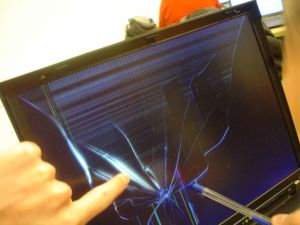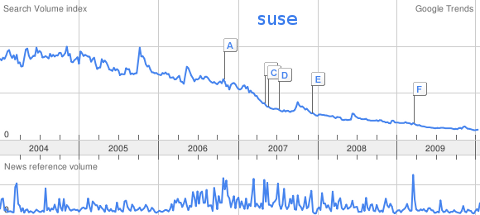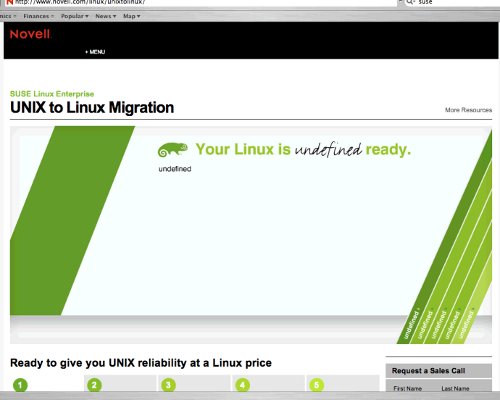04.24.10
Posted in IBM, LG, Linspire, Novell, Samsung, SLES/SLED, Xandros at 11:45 am by Dr. Roy Schestowitz

Summary: IBM and Novell grow a little closer; Verizon and SpagoBI make use of SUSE as well; other Ballnux distributions have little to say
SUSE (SLES/SLED)
MOST of the SUSE news this week relates to IBM and/or Studio, starting with this article about IBM’s Power7.
Read the rest of this entry »
Permalink
 Send this to a friend
Send this to a friend
04.17.10
Posted in IBM, Linspire, Microsoft, Novell, Red Hat, Servers, SLES/SLED, Xandros at 8:28 am by Dr. Roy Schestowitz

Summary: A survey of the past two week’s news shows where SLES is gaining and where it is losing
NOVELL’S SLES is occasionally being listed as a supported platform on a variety of servers, but there are barriers to it. Red Hat is still way ahead of SLES when it comes to deployment:
Today’s data centers are moving toward only two important non-mainframe server operating systems — Red Hat Enterprise Linux and Windows — dominating the commercial operating system market. Proprietary Unix is on the downswing, with many Unix systems (AIX, HP-UX and Solaris), and the SCO operating systems being migrated to Linux or Windows. NetWare has been on a very steep decline for several years and Novell recently ended general support for Netware. IBM’s z/OS and z/VM are still holding their own as mainframe operating systems.
[...]
The questions are: Why is Novell, the second-largest commercial Linux server operating system vendor, being discounted as a serious Linux operating system vendor over the next few years?And what does this mean to you, the IT director?
Nat Friedman was promoting SLED (see these two videos which have just been uploaded [1, 2]), but he left Novell some months ago and Novell keeps talking about Vista 7 rather than SLED.
There are some new videos about SUSE Moblin and SLED, but Novell is not doing enough.
On the server side, Timothy Prickett Morgan mentions SLES as supported here, here, here, and here (along with RHEL).
IBM’s i 7.1 and AIX 5.3 and 6.1, and Red Hat’s Enterprise Linux 5.5, and Novell’s SUSE Linux Enterprise Server 10 SP3 are supported on the blades. SLES 11 will be supported later this quarter when SP1 for that OS comes out.
Another one from Timothy Prickett Morgan shows the relation to IBM:
Big Blue juices OS formerly known as 400
[...]
This can be done quickly, and a partition can be trashed when the testing is over. i 7.1 logical partitions can create guest partitions based on i 7.1 or i 6.1. Guest partitions can also be spun up for AIX 5.2, 5.3, and 6.1 as well as the Linux distros from Red Hat and Novell.
Novell’s tag-team act with IBM (intended to sell its proprietary products) will lead to even more promotion of SaaS rather than Free software on one’s own desktop. Novell’s special relationship with IBM mainframes can also be seen here. SaaS at Verizon will involve SLES but not RHEL, which is not entirely odd but Verizon used to work a lot with Red Hat. Did half a billion dollars from Microsoft change Verizon’s mind?
Verizon also expanded the applications and operating systems supported by SaaS, adding SUSE Linux, which is commonly used in ERP packages; and Microsoft (NSDQ:MSFT) SQL Server 2008, which has been added as a click-to-provision server option. The addition of SUSE Linux and SQL Server 2008 augments the support for Windows, Red Hat, Apache and SQL Server 2005 that CaaS already supports.
More about Verizon here:
Enhancements to the CaaS offering include support for server cloning and the SUSE Linux operating system.
Here is the corresponding press release:
The SUSE Linux operating system is now supported on the Verizon CaaS platform as a standard service offering. Linux software is used with commonly deployed enterprise resource planning packages. In addition, Microsoft SQL Server 2008 has been added as a “click-to-provision” database server option.
Here is Microsoft piggybacking SUSE into HPC yet again. How does IBM feel about it? The Microsoft boosters sure seem happy about the whole thing.
The Linux and Windows interoperability efforts from Microsoft and partners such as Novell have evolved to the HPC market.
Ingres got closer to SLES recently. It’s because of Studio appliances, which the company covered in three new videos [1, 2, 3] and also mentioned in a press release.
The SpagoBI Analytical Appliance integrates SpagoBI, the only entirely open source suite covering all the analytical areas of business intelligence projects, Ingres Database, the leading open source database that helps organizations develop and manage business critical applications at an affordable cost, and SUSE® Linux Enterprise 11 from Novell®.
SGI still supports both RHEL and SLES, based on its new press release which says:
At the system software level, Cyclone offers a flexible computing environment with choice of Novell(R) SUSE(R) or Red Hat(R) Linux(R) operating systems, further performance-optimized through the addition of SGI(R) ProPack(TM).
Novell is the last distributor of GNU/Linux which poses a real problem because it pays Microsoft for each copy of SLES. Xandros is mostly unheard of at this stage and the only mention of it that we have found this month (in English) was to do with Linspire, which it had acquired only to bury. Michael Robertson still deals with litigation:
Robertson, the controversy-courting founder of MP3.com and Linspire, is preparing to roll out a new online music service called BYO.fm. He said that BYO taps into Web radio’s potential to enable users to act as their own program directors.
Michael Robertson’s lawsuit against Carmony (and vice versa) seems to have ended rather quietly. Maybe it’s better that way. █
Permalink
 Send this to a friend
Send this to a friend
03.13.10
Posted in GNU/Linux, Linspire, Microsoft, Novell, Samsung, SLES/SLED, Xandros at 12:58 pm by Dr. Roy Schestowitz

Summary: News and coverage concerning the distributions which joined Microsoft’s patent racket against GNU/Linux
SUSE (SLES/SLED)
GroundWork continues to favour SLES for some reason and there is a new press release about it.
GroundWork Open Source, Inc. (GWOS http://www.gwos.com), the leader in commercial open source systems and network management software, today announced it will conclude the GWOS barCAMP Deux sessions with an exclusive release of a SUSE powered Virtual Appliance package that integrates GroundWork Monitor Enterprise 6.1 with Zendesk (www.zendesk.com).
At the high end, IBM deploys SLES for some large companies with mission-critical systems.
Implementing an IBM System z10 Enterprise Linux Server helps EFiS EDI Finance Service AG save money and the environment
Here is some guidance for anyone who wants SLED 11 installed on this HP hardware:
However, we still tested the stock version and came away impressed. For the vast majority of computing tasks – using Evolution to check your POP mail, burning a DVD disc using LightScribe (included with this SLED build) and even playing games or watching movies – the Elite 7000 is up to the task. Where we noticed a performance degradation is when we compared Linux-to-Linux between this system and a home-built PC that uses an SSD drive, an Nvidia Quadro CX graphics card and has 6GB of RAM. There was no comparison, of course – the home-built system was snappier even for popping up Firefox, copying files and running simulations with a program like Autodesk Revit Architecture (which normally prefers a workstation PC).
That’s about it when it comes to SLE*.
Xandros/Linspire
Another distribution that we name “Ballnux” would have to be Xandros because Linspire and Turbolinux are more or less history. Here is a little new rant about Xandros:
Linpus and Xandros aren’t looking quite so exciting. Of course, that could change as smartbooks with ARM-based processors start to hit the market, since they’re not capable of running Windows.
Not looking like Windows does not make something deficient. People don’t need Windows, they just need something that works. But anyway, Lindows, which was bought by Xandros in its “Linspire” form, is now being called one of the “worst products ever”.
9. Lindows
The hype was palpable surrounding Lindows: it was going to be a Linux operating system that provided full compatibility with Windows. Microsoft didn’t take kindly to this and even sued, unsuccessfully, saying that Lindows was infringing its Windows copyright. The court case just added to the excitement.
Xandros never did anything substantial with Linspire, not even with CNR.
Samsung
Microsoft is also extorting Linux phones and Samsung lets Microsoft get its way. Here is a new discussion about Samsung’s Android phones and about Bada:
Many people think of it as a poor thought, but Samsung has made it clear that Samsung Bada is being launched to make smartphones accessible to everyone. The smartphone market is still in its growing phase and Bada platform aims at improving the current situation.
Bada is mostly a layer and the platform that’s underneath benefits Microsoft if people buy their phones from Samsung. █
Permalink
 Send this to a friend
Send this to a friend
03.08.10
Posted in Boycott Novell, GNU/Linux, Linspire, Mandriva, Microsoft, Novell, Red Hat, Site News, Turbolinux, Ubuntu, Xandros at 7:24 am by Dr. Roy Schestowitz

Summary: A little interlude about where the site is going and why it needs help from readers
There is some discussion in the IRC channel about what may happen to Novell next. We are still producing almost 1 megabyte of IRC discussion per day (usually about 600 kilobytes on average), which makes up about 95% of feedback from readers (Boycott Novell is approaching an audience of 10,000 unique visitors per day, but commenting requires an account).
We thought it would be reasonable to say something about the future now that Novell is at a mortal crossroad because of a vulture fund that had a coup planned for 3-4 months [1, 2, 3, 4, 5, 6, 7]. We append some more references at the bottom.
“If Novell was bought and dismantled, this Web site’s name would remain for all all sorts of practical/technical reasons and considerations.”Four GNU/Linux vendors (as opposed to users of it, mostly those who embed it in hardware) signed a Linux patent deal with Microsoft in 2006-2007. The GPLv3 may have stopped this flood of feeble vendors which ended up joining the racket. Linspire got picked up by Xandros, which appears to have almost quit the GNU/Linux market, Turbolinux sort of collapsed onto another firm in Asia, and Novell is now the last one standing. This is major as it means that almost all the companies we boycotted are dying, as opposed to those who kept it ‘clean’ (notably Mandriva, Canonical, and Red Hat). This just comes to show what happens to those who foolishly take Microsoft’s side.
The main issues are still the digital hydras known as Apple and Microsoft, both of which are now legally attacking GNU/Linux with software patents (Apple versus HTC [1, 2, 3, 4, 5], Microsoft versus TomTom, SCO versus IBM, et cetera).
If Novell was bought and dismantled, this Web site’s name would remain for all all sorts of practical/technical reasons and considerations.
We will try to focus on delivering news summaries on a daily basis (these are the most popular items here) and also address threats to Free software. With a Ph.D. completed, I hope to write Boycott Novell full time (sacrificing an academic career to advance the freedom of software), but it would not be possible without help from readers. We estimate that there are many thousands of regular readers who have enjoyed this site for over 3 years (almost 10,000 blog posts were published here), so if each reader was willing to donate a few bucks/quid, that would enable us to carry on going. At the same time, we realise that such moves rarely work as they do not bring in funds, so we are left reluctant to ask for financial assistance (even though it’s needed). Any advice would be appreciated. █
____
[1] How Much Will Novell Go For? [The 451 Group reckons Novell's sale is inevitable]
As bargains go, Novell’s (NOVL) valuation in the recently floated bid from a hedge fund is a bit like a ‘crazy Eddie’ discount. Earlier this week, Elliott Associates offered $5.75 for each of the roughly 350,000 shares for Novell. Altogether, the equity value totals about $2bn.
[2] Will Novell Finally Be Acquired? [from the 'Microsoft press']
[3] Novell Gets $2 Billion Takeover Offer From Elliott
Whether they’re interested in breaking Novell into pieces or simply after Novell’s patent portfolio or intellectual property remains to be seen at this point. Either way I don’t see the acquisition being good for Novell or Open Source though. Which brings the next question. Is another suitor likely to jump in at this point. the Var Guy lists IBM, Hewlett-Packard, Microsoft, Oracle, SAP and Computer Associates as potential options. I’d add Cisco as another potential Dark Horse candidate, but agree that IBM and HP are exceedingly unlikely. The realty is that Novell is going to be difficult to digest from a strategic standpoint. They have at least four divergent businesses and Linux only makes up about 20% of the company’s revenue. That means a private-equity firm taking the company private and restructuring may be the most viable option at this point.
[4] BBC America: Palast Hunts the Vultures [hedge funds are so unethical that some consider banning them]
Some vultures have feathers, but some have fancy offices and huge homes. Tonight, BBC investigative reporter Greg Palast follows the trail of one “vulture fund” chief, from a locked office door in New York to mud-brick houses in Africa.
How strange. When I arrive at the offices of Eric Hermann at hedge fund FH International, just outside New York City, the company’s corporate sign is unbolted from the wall and the suite number removed from the door.
But wait … I hear noises inside the office. Huh? I knock on the locked door and out steps the office building’s security manager.
Permalink
 Send this to a friend
Send this to a friend
02.13.10
Posted in GNU/Linux, Kyocera Mita, LG, Linspire, Microsoft, Novell, Patents, Samsung, SLES/SLED, Xandros at 11:20 am by Dr. Roy Schestowitz

Summary: News about the different types of “Ballnux” distributions (ones from which Microsoft extracts profit through intimidation and collusion)
SUSE (SLES/SLED)
THERE HAS BEEN NO major news about SLE* in the month of February, but the product in being used or deployed in some areas. Novell’s marketing people write about the SUSE appliance of ROC EasySpooler. Here is the press release (also here):
ROC Software Systems Inc. announces the first release of the ROC EasySpooler SUSE-powered appliance. Based on the reliable ROC EasySpooler core technology and a fully supported version of SUSE Linux Enterprise from Novell, the appliance provides the highest level of print output management available to any business environment.
Here is something related that was mentioned two or three weeks ago when the press release came out.
Read the rest of this entry »
Permalink
 Send this to a friend
Send this to a friend
01.29.10
Posted in GNU/Linux, Linspire, Microsoft, Novell, OpenSUSE, Patents, Turbolinux, Xandros at 8:24 am by Dr. Roy Schestowitz

Google trends for TurboLinux (search volume)
Summary: iSoft buys TurboSystems and Novell is in a state of disarray
THE company known as TurboSystems lost its way after it had signed a patent deal with Microsoft. It sold out. According to the news (most of the coverage is in Asian languages), “iSoft Infrastructure Software Co Ltd, a Chinese software company, yesterday announced that it has bought a 51% stake in Japan’s TurboSystems, which belongs to Turbolinux and specially engaged in researching and developing the Linux technology, sources reported.” The headline says that “China’s iSoft buys Japan’s TurboSystems”, so it’s likely to be a complete acquisition (or a majority stake). There’s heaps of coverage in Chinese and it can hopefully draw an accurate picture.
Turbolinux seems like it’s over. Our last update on its terminal state showed that it was just one of those companies that lost GNU/Linux focus after Microsoft deals. What happens to Turbolinux right now is similar the story of Linspire-Xandros. Linspire got absorbed only to be put in its deathbed. This is okay because both Xandros and Linspire sold out to Microsoft, deciding to promote OOXML and to pay Microsoft for imaginary patents. The fewer of these companies that are left, the better. It’s down from 4 to just two now, Xandros and Novell.
“The problem of distributions that sell out to Microsoft is made more densely contained as their activities are ebbing.”Xandros said that it was more or less quiting its “Linux” direction and Novell too seems more focused on Microsoft technology (this one is from yesterday, posted by a Microsoft MVP who is a Novell vice president), just like Corel after the Microsoft deal [1, 2, 3, 4, 5, 6].
The problem of distributions that sell out to Microsoft is made more densely contained as their activities are ebbing. Novell is arguably the only sellout left now; it makes it a lot easier for us to track the problem with distributions whose use is harmful for GNU/Linux and Free software. Back in 2007 the problem had spread to four separate distributions, 3 of which merely followed the “Novell model”. That’s what makes Novell so unique, except for its size.
As for Novell itself, its SUSE efforts are shattered by the abandonment of Zonker (the latest among several managers like Levy, Jaffe and Friedman, who leave Novell as well). SUSE is crumbling and Michael Löffler looks for a new Community Manager:
In the meantime, I will be working with Andreas Jaeger and other Novell colleagues in marketing and engineering to cover openSUSE community relations activities.
The comments there are interesting too. Back in 2006 SUSE was probably the leading GNU/Linux distribution for the desktop (exceeding even Ubuntu). The deal with Microsoft turned Novell from hero to zero overnight. █

Permalink
 Send this to a friend
Send this to a friend
11.21.09
Posted in GNU/Linux, Linspire, Microsoft, Novell, Patents, Samsung, Servers, SLES/SLED, Xandros at 8:32 am by Dr. Roy Schestowitz

Summary: News catchup with vendors that pay Microsoft for the use of Linux
SUSE (SLES/SLED) hardly appears in the news these days. The exception is stories where RHEL and SLE* are aligned as “officially supported” distributions. Such is the case with SGI news that got covered in:
i. SGI unveils new supercomputer Altix UV
According to SGI, based on open standards, the system’s x86 architecture leverages quad, six or eight-core Intel Xeon processors, codenamed Nehalem-EX. It allows for the use of completely unmodified Novell SUSE or Red Hat Linux operating systems. It is suitable for open source, custom and commercial applications, ranging from technical computing applications like Ansys Fluent to enterprise applications like Oracle.
ii. SGI previews UltraViolet Nehalem EX blade clusters
The Altix UV systems will support Novell SUSE Linux or Red Hat Enterprise Linux, and will run out of the box without any modifications to the Linux code.
iii. SGI Intros Supercomputer With Intel Nehalem EX
The Altix UV’s x86 architecture enables it to run unmodified Novell SUSE or Red Hat Linux operating systems. SGI says the supercomputer is designed for running open source, custom, and commercial applications, ranging from technical applications like ANSYS FLUENT to enterprise applications like Oracle or SAP.
Novell wrote about its relationship with SAP and then there is SEP:
SEP Releases ‘SEP sesam Bare System Recovery for Novell Linux’
[...]
With the release of “SEP sesam Bare System Recovery for SLES Linux” SEP AG further enhances its backup and recovery software portfolio to provide a fast and secure methodology to recover from a major hardware failure.
Novell also wrote about the SUSE Appliance Program, which is related to SUSE Studio.
Today we are introducing the first in a series of podcasts featuring the SUSE Appliance Program and our ISV partners.
Cornelius Schumacher wrote about the versatile SUSE Studio and founder of “Nothing Is Impossible Studio” is supporting SUSE now, along with other GNU/Linux distributions.
Hollar, formerly a systems engineer with BrigTech Consulting of Reston, Virginia, and founder Nothing Is Impossible Studio, a multi-player online game publisher, works with Linux, including Red Hat, Novell and Debian systems.
Open Enterprise Server 2 has its second service pack (it is based on SUSE) while Netware and OES are mentioned for support in this new article about HP.
The software supports HP servers and storage running Microsoft Windows, Red Hat Enterprise Linux, SUSE Linux Enterprise Server, and Novell Open Enterprise Server for Netware and Linux.
Linspire
Linspire is part of Xandros now and its founder is still in hot legal water. Linspire/Lindows gets mentioned here, but in general, Linspire is more of a history now. It’s like Napster.
Samsung
Samsung is one of the companies that sold out to Microsoft and helped it apply a “patent tax” to Linux. Samsung is bringing some Linux phones to Europe (where software patents are void), sometimes via carriers like Vodafone, which is run by a former Microsoft executive [1, 2]. We wrote about this before.
Samsung announced an Android-powered “Galaxy Spica I5700″ smartphone, targeting Europe. In other Android news, Dell confirmed Brazilian and Chinese carriers for its Dell Mini 3, Google released a second-generation developers phone, and ZiiLabs is prepping an Android platform, say reports.
Luckily, Samsung’s phones lag behind the Linux competition which is not submissive to Microsoft.
Like the H1, the M1 has an innovative user interface that puts your contacts front and centre, and uses the Linux-based LiMo operating system. It’s a cool idea, but when we reviewed the Samsung H1 we found the whole thing a bit confusing.
To quote The Mirror:
Gadget review: Vodafone 360 H1 by Samsung
[...]
A nice effort, but there’s little to recommend this above HTC’s Hero or an iPhone.
There is also this:
The Vodafone 360 is currently accessible through desktop computer and on the Vodafone 360 H1 and M1 Linux Mobile phones by Samsung.
It is rather surprising to learn that Samsung may be placing its cards on Enlightenment.
Back in June Enlightenment E16 reached version 1.0.0 and then a few weeks later there was an E17 development snapshot released, but there hasn’t been a whole lot of news out of the Enlightenment camp over the past year.
The H (Heise) wrote about it the following:
Samsung may be sponsoring the Enlightenment window manager project and Enlightenment may be a component in Samsung’s bada mobile operating system. The Enlightenment project, which has been around since 1997, announced today that it was working with a “top-tier electronics maker” which “produces millions of mobile phones, televisions, sound systems and more”.
Our reader MinceR has asked, “any info on Bada besides the press release? And that it’s perhaps based on Enlightenment…”
It could be sarcastically argued that “Bada is Ballnux” because Samsung has a Linux patent deal with Ballmer. We continue to remind people not to touch Samsung products. They need to be persuaded to distance themselves from Microsoft and cancel their patent deal that harms GNU/Linux.
Sadly, Samsung receives preferential treatment in its own country, Korea.
LiMo Foundation announced that Korean wireless provider SK Telecom will deploy a Samsung-made “SCH-M510 “phone that complies with the LiMo (Linux Mobile) specification and offers a 3.5-inch AMOLED display. Meanwhile, LG Electronics, Samsung, SK Telecom, and the Korean government have launched the Korea LiMo Ecosystem Association to promote LiMo app development, says the Foundation.
We previously explained what Samsung does to LiMo [1, 2], emphasising the fact that even in Korea, Samsung helps spread Microsoft’s patent abuse against Linux. The least one can do is avoid Samsung and tell others to do the same. █
Permalink
 Send this to a friend
Send this to a friend
10.24.09
Posted in GNU/Linux, Linspire, Novell, OpenSUSE, Red Hat, SLES/SLED, Xandros at 5:38 am by Dr. Roy Schestowitz

Really bizarre Novell Web page (real screenshot)
Summary: News about OpenSUSE, SLE*, and a little update from Linspire
OpenSUSE
TWO weeks ago we saw the formation of the OpenSUSE Boosting Team. They sure have a good sense of humour:
[...]
Busily,
The Propaganda Minister
Looking at coming events, Zonker will attend the Linux Fest in Ontario, Canada. OpenSUSE will also have presence at Encuentro Linux 2009.
Yes, I am going to Encuentro Linux 2009, and so does openSUSE!.
OpenSUSE 11.2 is almost ready to roll now and it will come with the excellent KDE 4.3.2 as the default desktop environment.
The 4.3.2 release of KDE came too late to be included in openSUSE 11.2. As the distribution release gets closer, there is a certain point after which only reviewed changes should be allowed in, in order to reduce the possibility of these changes causing unexpected breakages that might go unnoticed within the relatively short time until the release. This can happen and it wouldn’t be very good to fix something small and break something bigger for the release because of some unnoticed mistake. So openSUSE 11.2 will not officially include KDE 4.3.2.
To say more about the looming launch:
There is a lot of buzz in the tech media world about the upcoming Ubuntu Karmic Koala release, but it’s not the only Linux release on its way from a major vendor. Novell’s (NASDAQ: NOVL) community-driven openSUSE project is nearing completion of its next major release, version 11.2
The first release candidate for openSUSE 11.2 was released this week and includes the latest Linux 2.6.31.3 kernel, social networking support and the inclusion of the GNOME 2.28 desktop, among other new features. While both the latest GNOME and KDE desktops are part of the openSUSE 11.2 release, the KDE desktop will now become the default choice for desktop GUI instead of GNOME. The move to make KDE the default choice is not seen by openSUSE as a shift, but rather a choice for users.
On the technical side, Andreas Jaeger weighed in on packaging contributions and Pascal wrote about OpenSUSE Build Service.
We are currently switching from OBS (openSUSE Build Service) version 1.6.0 to the latest SVN trunk HEAD, which requires some experimentation and also caused a complete rebuild (for unknown reasons).
Here is an analysis of how free (as in Freedom) OpenSUSE Build Service really is.
Aaron Seigo, one of my favourite blogger, recently wrote a text titled freedom services where he highlighted aspects of freedom of online services. Aaron found four bullet points which need to be fulfilled to form a free service. I was thinking about how good the openSUSE Buildservice is in this regard. The Buildservice might not be a ‘classical’ online service yet, but who knows how things develop and where and how the OBS gets integrated. There are plenty of ideas around in that direction.
Scott Morris from SUSE Rants writes about “When 1-Click Install Bites the Dust.”
In OpenSUSE Linux, we have a wonderful thing called One-Click Install. This is a marvelous thing for new users. I love it to death, and care for it as I would my own child. Almost everyone knows that this is very cool except for maybe Christer, as he is not a believer (nuttin but love bro, loved your presentation @ UTOSC). That said, what happens when it stops working or gets broken?
AutoYaST is already here and when it comes to RPM, a Novell employee writes about “interoperability efforts” (more of a Microsoft-esque term, typically used when standards are neglected).
Bubli said that it might be a good idea to write an article of a very basic step by step instruction for AutoYaST and I had to agree with that. So this is more for people who don’t ask questions like “can I use the ‘ask’ feature for ‘rules’ in AutoYaST?” 
Repository branching takes place ahead of the official arrival of OpenSUSE 11.2:
As you might know, Contrib is a universal repository for third-party packages. Branching of this repository to openSUSE:11.2:Contrib is going to happen on October, 30, so if you want to have your favorite application or tool included in openSUSE:11.2:Contrib, please submit your request as soon as possible.
More packages are being built for OpenSUSE and there is even a Firefox Personas entry for it.
Moving on with this technical side of things, except for some OpenSUSE instructions we have also found some raves, such as a recommendation from SJVN, who loves SLED.
OpenSUSE
OpenSUSE, like Fedora, is also a major distributor’s community Linux. In this case, Novell (http://www.novell.com) is the company behind the distro. Unlike Fedora, however, openSUSE tends to be less bleeding edge and more stable. It also includes software like Mono, which brings .NET programs to Linux, along with other Windows-friendly software. Free-software purists hate this and so tend to avoid Novell and openSUSE. Personally, I have little problem with that, and I like openSUSE a lot. The latest version, openSUSE 11.2, is almost ready to go. I’m not ready to review it quite yet, but I can tell you already that it’s a winner.
Also, if you’re looking for PCs for a business, Novell is the only company that offers a Linux desktop, SLED (SUSE Linux Enterprise Desktop) with all the enterprise support trimmings and Windows domain and AD (Active Directory) compatibility. If I were running a business today, my desktops would probably be running SLED.
OpenSUSE is also mentioned in this roundup of distributions that will soon be released, amongst other similar lists.
- openSuSE 11.2: Due just over a week after Mandriva 2010, on 12 November. Once again, Linux kernel 2.6.31, KDE 4.3 and Gnome 2.28, and a variety of other new packages. Maybe it’s just me, but it seems like openSuSE has made some huge strides forward in usability, flexibility, reliability and even cosmetics over the past couple of releases, and this one looks like it will be no exception. I’ve had it loaded on various of my systems since about Milestone 3, and it has been interesting to watch how the diversity of systems on which it installs and runs easily has improved.
Here is the latest OpenSUSE Weekly News, as well as a reminder and announcement of a translation tool for it.
SUSE (SLES/SLED)
Last week we wrote about SUSE support in new Compaq/HP computers and there is still some coverage of that.
This week we have Teradata, which came out with the following press release that includes:
Teradata Express Cloud Offerings
The two new Teradata Express cloud offerings are built on Teradata Express, which is a free, non-production version of Teradata Database software intended for developers and evaluation scenarios. The cloud versions of Teradata Express support up to one terabyte of data and are powered by Novell SUSE Linux Enterprise Server 10.
Here is some news coverage of the SUSE part:
Teradata will add cloud versions of Teradata Express to support up to 1TB of data and powered by Novell SUSE Linux Enterprise Server 10.
SP3 of SLE* 10 is still being mentioned in some Web sites:
Novell announced the availability of SUSE Linux Enterprise 10 Service Pack 3, offering customers the latest fixes, patches and updates issued for the SUSE Linux Enterprise 10 platform, as well as support for the latest hardware.
As a minor last note about Linspire, the fight against Michael Robertson carries on as he loses his case [1, 2]. And in other Robertson news, the media industry wants to sue personally. Tough times for him. His Linspire identity got lost inside Xandros. █
Permalink
 Send this to a friend
Send this to a friend
« Previous Page — « Previous entries « Previous Page · Next Page » Next entries » — Next Page »


























 Content is available under CC-BY-SA
Content is available under CC-BY-SA